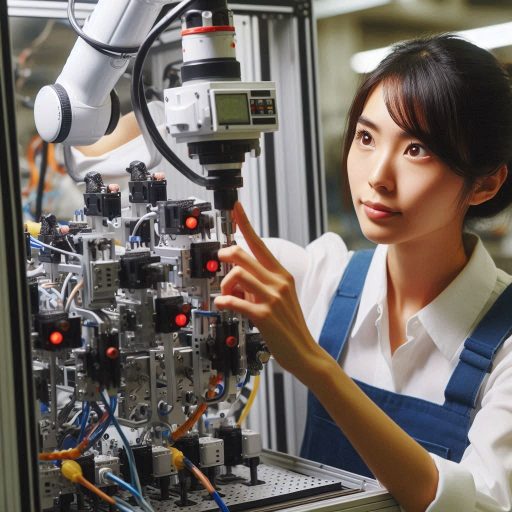Introduction
Smart cities are emerging as the future of urban living, combining advanced technologies to create more efficient, sustainable, and responsive urban environments.
Robotics engineers are the key players in this transformation, driving the integration of automation and artificial intelligence into the very fabric of city life.
These professionals are responsible for designing and implementing autonomous systems that manage everything from traffic flow to public transportation, reducing congestion and enhancing the efficiency of urban mobility.
Robotics engineers also play a crucial role in energy management within smart cities.
They develop systems that optimize energy consumption, ensuring that resources are used more effectively and reducing the overall carbon footprint of urban areas.
In addition, their work in waste management systems helps cities minimize waste production and improve recycling processes, contributing to a cleaner and more sustainable environment.
Another significant area where robotics engineers make a substantial impact is in public safety.
They design and deploy intelligent surveillance systems that can monitor vast urban spaces, detect anomalies, and respond to potential threats in real time.
These systems enhance security while reducing the need for human intervention, making cities safer for their inhabitants.
The Definition of Robotics Engineers in Smart Cities
What Robotics Engineers Are and Their Specific Role in Smart City Development
Robotics engineers specialize in designing, building, and maintaining automated systems that handle tasks traditionally performed by humans.
In smart cities, these engineers are pivotal, integrating advanced robotic systems into urban infrastructures.
Their responsibilities range from developing autonomous vehicles that navigate city streets to creating automated systems for energy management, waste processing, and public safety.
Robotics engineers design robots and automation technologies that streamline city operations, making them more efficient and sustainable.
For example, they create autonomous vehicles that reduce traffic congestion, lower emissions, and enhance overall transportation efficiency.
They also develop smart grids that optimize energy consumption and integrate renewable sources, ensuring a balanced and sustainable energy supply.
In waste management, robotics engineers design robots that sort and process waste, improving recycling rates and reducing landfill use.
Their contributions extend to public safety, where they design surveillance systems that monitor urban areas and respond to potential threats in real time.
Importance of Their Skills and Expertise in Creating Innovative Solutions for Urban Challenges
The skills and expertise of robotics engineers are crucial in addressing the complex challenges of modern urbanization.
They bring together knowledge from mechanical engineering, computer science, and artificial intelligence to develop innovative solutions that enhance urban life.
Robotics engineers are essential in creating smart systems that improve the efficiency, sustainability, and resilience of cities.
Their ability to design and implement complex automated systems makes them indispensable in the development of smart cities.
These engineers are responsible for optimizing energy usage through smart grids, enhancing public safety with advanced surveillance systems, and improving waste management with automated sorting technologies.
As cities continue to grow and evolve, the demand for robotics engineers will increase, making their role in urban development even more critical.
Their expertise not only helps cities overcome current challenges but also ensures that urban environments can adapt to future needs, creating sustainable and livable spaces for generations to come.
Read: Environmental Engineers in the Mining Industry
Key Responsibilities of Robotics Engineers in Smart Cities
Designing and Implementing Robotic Systems for Various Applications
Robotics engineers are central to developing and implementing robotic systems that enhance smart cities.
They design technologies for transportation, waste management, and infrastructure maintenance, which are vital for creating efficient, sustainable urban environments.
In transportation, engineers develop autonomous vehicles that navigate cityscapes, reducing traffic congestion and lowering emissions.
These vehicles use sensors, machine learning, and real-time data to operate smoothly.
Autonomous buses, taxis, and drones are transforming urban mobility, improving the movement of people and goods.
For waste management, robotics engineers create automated systems to sort, collect, and process waste, boosting efficiency and cutting labor costs.
Smart waste bins and recycling robots make cities cleaner and more sustainable.
In infrastructure maintenance, engineers design robots that inspect, repair, and maintain essential structures like bridges and pipelines, reducing human risk and ensuring precision.
Collaborating with Other Professionals in Creating Integrated Solutions for Urban Problems
Successful integration of robotic systems in smart cities requires collaboration.
Robotics engineers work closely with urban planners, architects, and other professionals to address urban challenges.
This interdisciplinary approach ensures that robotic systems are effective and well-integrated into the city’s fabric.
For example, when developing autonomous transportation systems, engineers collaborate with traffic management experts to ensure smooth integration with existing infrastructure.
This teamwork ensures that new technologies complement rather than disrupt urban life.
Robotics engineers also partner with environmental scientists to develop waste management solutions that align with sustainability goals.
By working together, professionals from various fields can create holistic solutions that address multiple aspects of urban living, from transportation to waste disposal.
Ensuring the Safe and Efficient Operation of Robotic Technologies in Urban Environments
Safety and efficiency are paramount in the operation of robotic technologies in cities.
Robotics engineers rigorously test and monitor these systems to prevent accidents and malfunctions.
They implement safety protocols, fail-safes, and emergency response procedures to mitigate risks.
In smart cities, where robotics increasingly interact with the public, engineers must prioritize safety to build trust.
Ensuring the safe operation of autonomous vehicles, drones, and other robotic systems is crucial for public acceptance and widespread adoption.
Robotics engineers also focus on maintaining the efficiency of these systems.
Continuous monitoring and updates ensure that robotic technologies remain reliable and effective.
By prioritizing safety and efficiency, engineers help create urban environments that are not only smart but also secure and resilient.
Basically, robotics engineers are instrumental in transforming cities into smarter, more sustainable spaces.
Through their work in designing, implementing, and maintaining robotic systems, and by collaborating with other professionals, they ensure that cities are well-equipped to meet future challenges.
Read: Public Health and Environmental Engineering
Benefits of Robotics Engineers in Smart Cities
Increased Efficiency in City Operations Through Automation and Data Analysis
Robotics engineers play a crucial role in enhancing city operations through automation and data analysis.
By implementing intelligent systems, they streamline processes, making urban management more efficient.
Automated systems monitor traffic, manage waste, and regulate energy use, reducing the need for manual intervention.
These systems collect vast amounts of data, which robotics engineers analyze to optimize city functions.
By predicting trends and identifying inefficiencies, they help cities allocate resources more effectively.
This data-driven approach minimizes waste and ensures that city operations run smoothly, improving the quality of life for residents.
Reduction of Human Labor in Dangerous or Repetitive Tasks
Automation reduces the need for human involvement in dangerous or repetitive tasks, enhancing safety in cities.
Robotics engineers design and deploy machines that handle hazardous work, such as construction or waste management.
These machines can operate in environments that are unsafe for humans, reducing the risk of injury.
In addition, robots take over repetitive tasks, allowing human workers to focus on more complex and creative activities.
This shift not only improves worker safety but also increases productivity, as machines can work continuously without fatigue.
The reduction of human labor in these tasks also leads to lower operational costs.
Improvement of Urban Sustainability by Optimizing Resource Usage and Reducing Environmental Impact
Robotics engineers contribute significantly to urban sustainability by developing technologies that optimize resource usage and reduce environmental impact.
Automated systems control energy consumption in buildings, ensuring that power is used efficiently.
By monitoring and adjusting energy usage, these systems reduce waste and lower greenhouse gas emissions.
Robotics engineers also develop solutions for managing water resources more effectively, preventing overuse and contamination.
In waste management, automation separates recyclable materials, reducing landfill waste and promoting recycling.
By integrating these technologies, cities become more sustainable, conserving resources for future generations and minimizing their environmental footprint.
Robotics engineers are at the forefront of creating smarter, more efficient, and sustainable cities.
Through automation and data analysis, they enhance city operations, making urban environments safer and more productive.
By reducing the need for human labor in dangerous or repetitive tasks, they improve worker safety and efficiency.
Furthermore, their innovations in resource management contribute to urban sustainability, ensuring that cities can thrive while minimizing their environmental impact.
As cities continue to grow and evolve, the role of robotics engineers will become increasingly important in shaping the future of urban living.
Transform Your Career Today
Unlock a personalized career strategy that drives real results. Get tailored advice and a roadmap designed just for you.
Start NowRead: Environmental Engineering and Marine Conservation
Challenges Faced by Robotics Engineers in Smart Cities
Ethical Concerns Related to Automation and Job Displacement
Robotics engineers encounter significant ethical concerns, particularly when addressing automation and its impact on job displacement.
As robots increasingly assume repetitive tasks in industries such as manufacturing, logistics, and retail, they often replace human workers.
This displacement raises profound ethical questions about the trade-offs between efficiency and employment.
While automation drives productivity and reduces costs, it can also lead to widespread unemployment, especially among low-skilled workers.
Robotics engineers must consider the human cost of these advancements and seek ways to integrate robots without devastating communities.
One approach is to design systems that complement human labor rather than replace it.
Engineers can create robots that work alongside humans, enhancing productivity without eliminating jobs.
Another strategy involves focusing on developing new roles that emerge as automation increases.
Engineers can help identify areas where human skills remain invaluable, such as in complex problem-solving, creativity, and emotional intelligence.
By promoting these areas, engineers can contribute to the creation of new job opportunities.
Moreover, engineers must advocate for reskilling and upskilling programs that prepare displaced workers for new roles in a changing job market.
Collaboration with policymakers, educators, and industry leaders is essential in establishing initiatives that support workers transitioning from traditional jobs to tech-driven careers.
Ethical engineering should prioritize human welfare, ensuring that technological progress does not come at the expense of societal well-being.
Technical Challenges in Developing Reliable and Resilient Robotic Systems
Developing reliable and resilient robotic systems presents a range of technical challenges, particularly in the context of smart cities.
Robotics engineers are tasked with ensuring that robots can perform consistently and safely in dynamic urban environments.
These environments are unpredictable, with variables such as weather conditions, traffic patterns, and human behavior constantly changing.
Robots must be equipped with advanced sensors, robust algorithms, and adaptive systems to navigate these challenges effectively.
One of the primary challenges is ensuring that robots can operate autonomously while maintaining safety.
In smart cities, robots might be deployed for tasks like delivery services, waste management, or public safety.
Engineers must design systems that can detect and respond to obstacles, communicate with other machines, and make decisions in real-time.
Achieving this level of autonomy requires continuous refinement of machine learning models, sensor technologies, and communication protocols.
Another critical aspect is addressing power consumption and energy efficiency.
Urban robots must operate for extended periods without frequent recharging, especially in tasks that require constant movement or heavy lifting.
Engineers must develop energy-efficient systems and explore alternative power sources, such as solar energy or advanced battery technologies, to ensure sustained operations.
Resilience is also a crucial factor, as system failures in urban environments can lead to significant disruptions.
Engineers must build redundancy into robotic systems, ensuring that they can continue functioning even if one component fails.
Regular maintenance, remote monitoring, and predictive analytics can help prevent failures and extend the lifespan of robotic systems.
By overcoming these technical challenges, engineers can develop robots that are both reliable and resilient, capable of supporting the complex demands of smart cities.
Regulatory Barriers in Implementing Robotic Technologies in Urban Environments
Implementing robotic technologies in urban environments involves navigating a complex landscape of regulatory barriers.
Government regulations often lag behind the rapid pace of technological advancements, creating challenges for robotics engineers seeking to deploy new systems.
These barriers typically revolve around concerns related to safety, privacy, and liability, which are critical in ensuring public trust and acceptance of robotic technologies.
Safety regulations are paramount, as robots operating in public spaces must not pose a risk to citizens.
Engineers must ensure that their systems meet stringent safety standards, which may involve extensive testing and certification processes.
This can slow down the deployment of new technologies, especially in sectors like autonomous vehicles or drone delivery services, where safety concerns are particularly high.
Privacy is another significant regulatory concern.
Robots equipped with cameras, sensors, and data-gathering capabilities can inadvertently infringe on personal privacy.
Engineers must design systems that respect privacy by implementing robust data encryption, anonymization, and data minimization practices.
Additionally, they must navigate varying privacy laws across different jurisdictions, which can complicate the deployment of robots in international markets.
Liability issues also present a challenge, as determining responsibility in the event of a robot-related incident can be complex.
Engineers must work closely with legal experts to establish clear guidelines on liability, ensuring that both manufacturers and operators are adequately protected.
This often requires collaboration with policymakers to develop new legal frameworks that accommodate the unique aspects of robotic technologies.
Read: Environmental Engineering and Corporate Social Responsibility

See Related Content: Radiologic Technologist Certification Requirements
Uncover the Details: Climate Change and Environmental Engineering
Case Studies of Robotics Engineers in Smart Cities
Examples of Successful Projects Where Robotics Engineers Have Made Significant Contributions to Urban Development
Robotics engineers have driven innovation in numerous urban development projects.
One prime example is the use of autonomous drones for infrastructure inspection.
Engineers designed these drones to detect and repair structural issues in bridges and skyscrapers.
This technology has dramatically reduced inspection time and costs.
In Tokyo, robotics engineers developed a smart waste management system.
They deployed robotic bins that sort and compact waste, optimizing recycling processes.
This system has minimized human labor and improved waste management efficiency.
Another successful project is the development of robotic street cleaners in Singapore.
These robots autonomously patrol streets, collecting litter and maintaining cleanliness with minimal human intervention.
In Barcelona, robots are enhancing public safety through surveillance and emergency response systems.
Engineers integrated autonomous robots into the city‘s security framework to monitor public spaces.
These robots can alert authorities to potential threats, improving overall safety.
Lessons Learned from Past Experiences That Can Inform Future Smart City Initiatives
Successful projects provide valuable lessons for future smart city developments.
Firstly, integrating robotics into existing infrastructure requires careful planning.
Engineers need to ensure that new technologies seamlessly fit with current systems.
Misalignment can lead to operational inefficiencies and increased costs.
Another key lesson is the importance of user acceptance.
In Tokyo and Barcelona, public support was crucial for the success of robotic systems.
Cities should involve community feedback in the planning stages to ensure that new technologies meet public needs and expectations.
Transform Your Career Today
Unlock a personalized career strategy that drives real results. Get tailored advice and a roadmap designed just for you.
Start NowData privacy and security are critical considerations.
Projects in various cities have faced challenges related to data protection.
Future smart city initiatives must prioritize robust security measures to safeguard sensitive information.
Collaboration between engineers, policymakers, and the community is essential.
Successful projects often involve multiple stakeholders working together.
Effective communication and joint efforts can address challenges and streamline implementation.
Finally, ongoing maintenance and support are vital. Robotics systems require regular updates and repairs to function optimally.
Cities should allocate resources for continuous maintenance to extend the lifespan and efficiency of robotic technologies.
These lessons can guide future smart city projects, ensuring they are efficient, secure, and well-received by the public.
As cities continue to evolve, robotics engineers will play a crucial role in shaping their development and enhancing urban living.
Future Trends in Robotics Engineering for Smart Cities
Emerging Technologies Shaping the Future of Smart Cities
Emerging technologies like artificial intelligence (AI), machine learning (ML), and the Internet of Things (IoT) are transforming the landscape of smart cities.
AI is revolutionizing the role of robotics in urban environments by enabling robots to analyze and interpret vast amounts of data.
This capability allows for better decision-making and improved efficiency in managing urban systems.
AI-driven robots can optimize traffic flow, enhance energy management, and streamline waste disposal processes, contributing to more sustainable and responsive cities.
Machine learning further enhances these capabilities by allowing robots to learn from their experiences and improve their performance over time.
This adaptive learning process means that robots can continually refine their operations, leading to increasingly effective solutions for urban challenges.
For instance, ML algorithms can help robots predict traffic patterns and adjust their behavior accordingly, reducing congestion and improving overall transportation efficiency.
The Internet of Things (IoT) connects various devices and systems within a city, creating a network that facilitates real-time data exchange and communication.
For robotics engineers, IoT integration means that robots can interact with other smart devices, sensors, and systems to gather and utilize data more effectively.
This connectivity enhances the functionality of robotic systems, enabling more precise monitoring and control of urban infrastructure.
IoT-enabled robots can manage energy consumption, monitor environmental conditions, and coordinate with other automated systems, contributing to the development of more intelligent and efficient cities.
Opportunities for Robotics Engineers to Drive Innovation and Transformation in Urban Environments
Robotics engineers have numerous opportunities to drive innovation and transformation within smart cities.
They can develop advanced autonomous vehicles that enhance traffic management and safety.
These vehicles use AI and IoT to navigate and communicate with other road users, reducing traffic congestion and minimizing accidents.
Additionally, robotics engineers can create smart waste management systems that use sensors and automation to sort and process recyclables more efficiently.
These systems can reduce landfill waste and promote recycling, contributing to a cleaner and more sustainable urban environment.
Engineers also have the potential to revolutionize public safety through robotics.
By developing advanced surveillance systems and automated emergency response robots, they can provide real-time data and support during emergencies.
This capability enhances the city‘s ability to respond quickly and effectively to crises, improving overall safety and resilience.
Moreover, robotics engineers can explore opportunities in infrastructure management, such as developing robots for routine maintenance and inspections.
These robots can perform tasks that are hazardous or difficult for humans, ensuring that infrastructure remains in optimal condition and reducing the risk of failures.
Importance of Continued Research and Development in Robotics to Address Evolving Urban Challenges
The importance of continued research and development in robotics cannot be overstated.
As cities grow and face new challenges, there is a constant need for innovative solutions to address these evolving issues.
Ongoing research ensures that robotics technologies remain cutting-edge and capable of meeting the demands of modern urban environments.
Investment in research supports the development of next-generation robotics systems that can tackle complex urban problems.
This includes enhancing existing technologies and exploring new approaches to robotics.
Collaboration among engineers, researchers, and city planners is essential for leveraging emerging technologies effectively.
By working together, stakeholders can harness the full potential of robotics to create smarter, more adaptable cities.
Continuous innovation in robotics will lead to more intelligent and efficient urban systems.
It will help cities manage resources better, respond to emergencies more effectively, and improve overall quality of life for residents.
As urban environments continue to evolve, robotics engineers will play a critical role in shaping their future, driving progress, and ensuring that cities are sustainable, resilient, and equipped to handle the challenges of tomorrow.
Conclusion
Robotics engineers are essential to the advancement of smart cities, playing a crucial role in the design, development, and integration of automated systems that enhance urban living.
Their expertise is instrumental in creating efficient, sustainable, and resilient urban environments, where technology seamlessly interacts with the city’s infrastructure.
Through robotics, engineers help optimize key areas like traffic management, waste disposal, and energy consumption, ensuring that cities operate with minimal environmental impact.
These systems not only streamline operations but also significantly improve the quality of life for residents by reducing congestion, pollution, and resource waste.
In addition to operational efficiency, robotics engineers contribute to public safety by developing advanced surveillance systems and automated emergency response mechanisms.
These innovations make cities safer and more adaptive to potential threats or natural disasters, ensuring resilience in the face of challenges.
However, the full potential of smart cities can only be realized through strong collaboration between governments, industries, and robotics engineers.
Such partnerships are vital for developing and deploying the technologies needed to transform urban environments into truly smart cities.
Investment in robotics technology is critical to this transformation.




